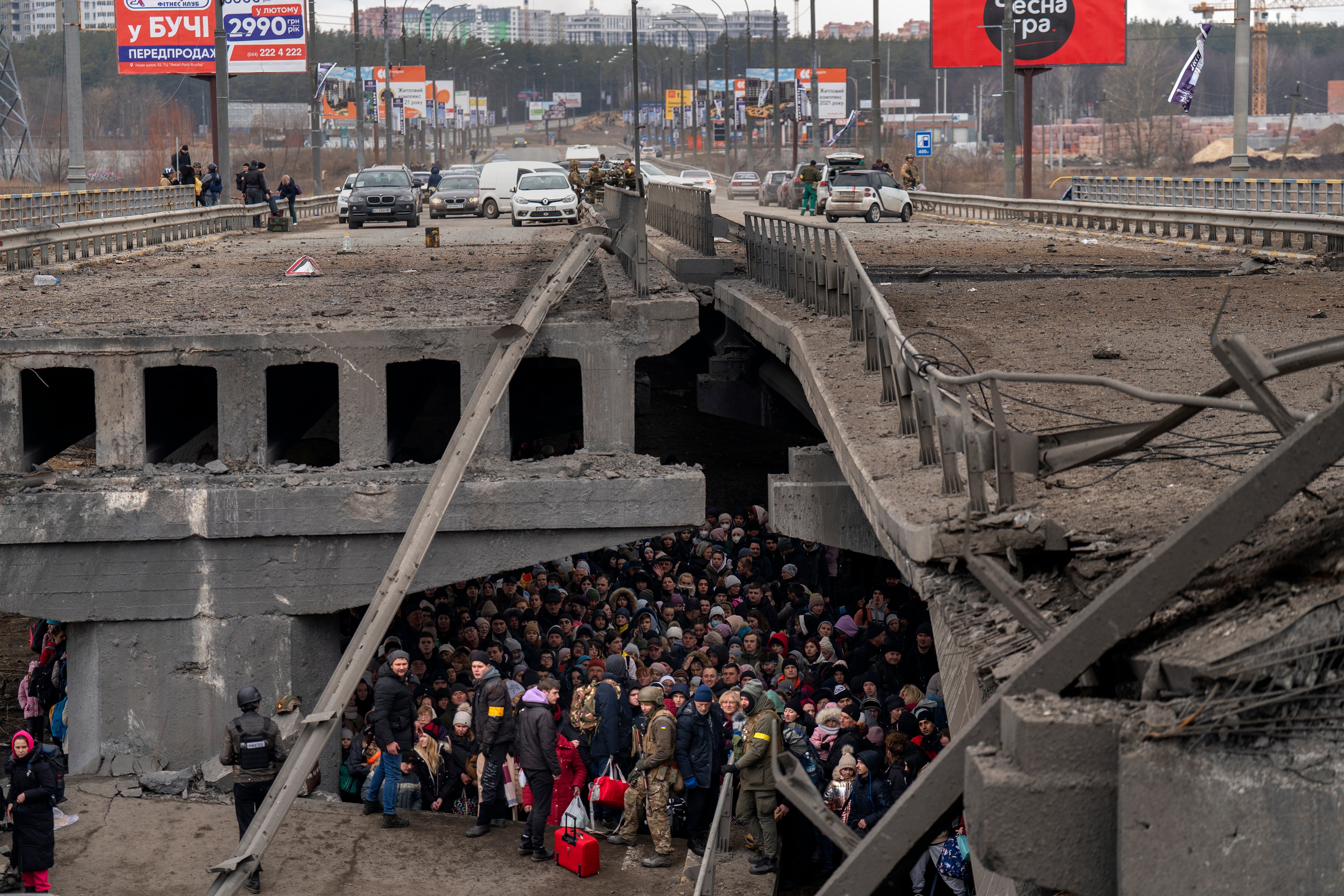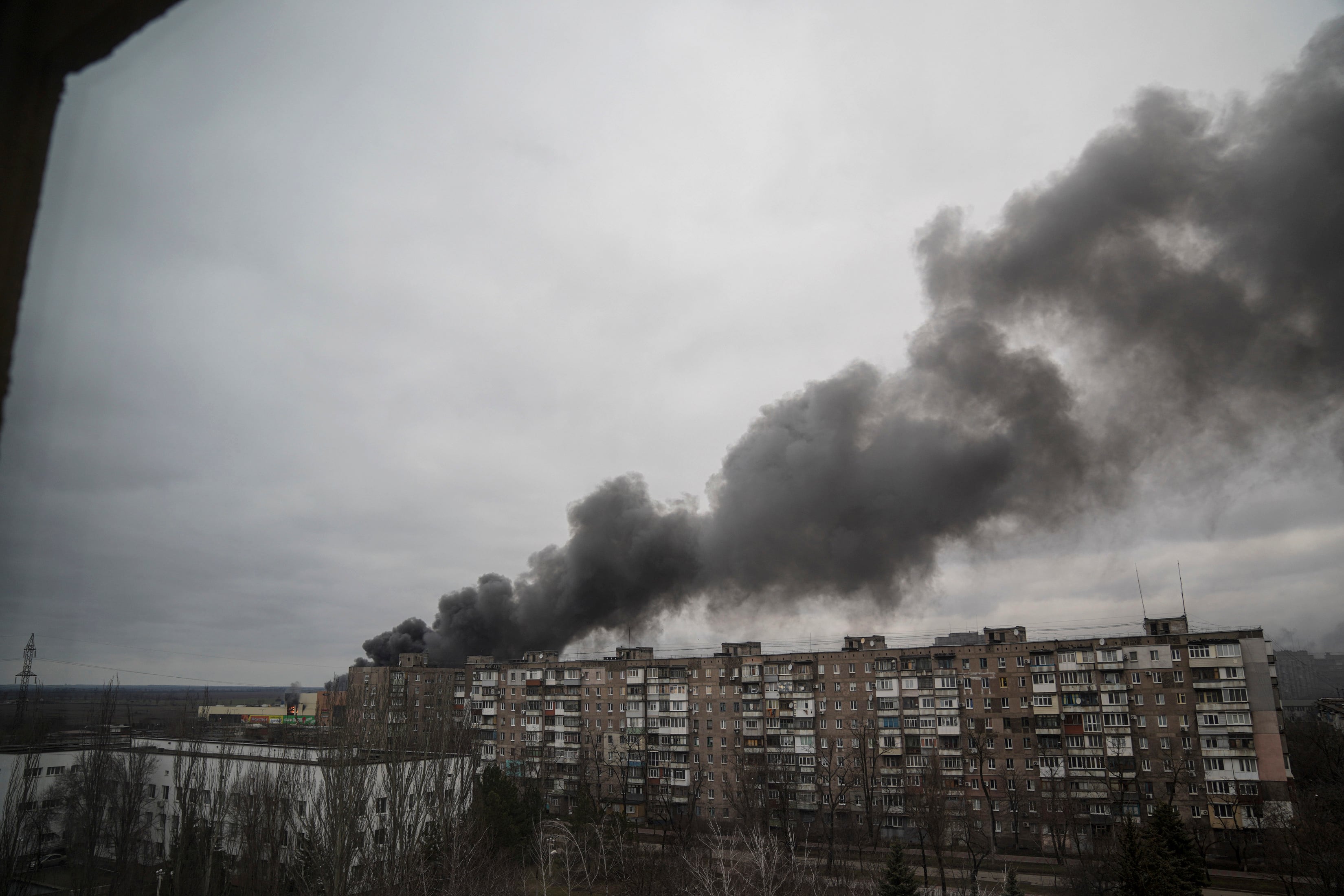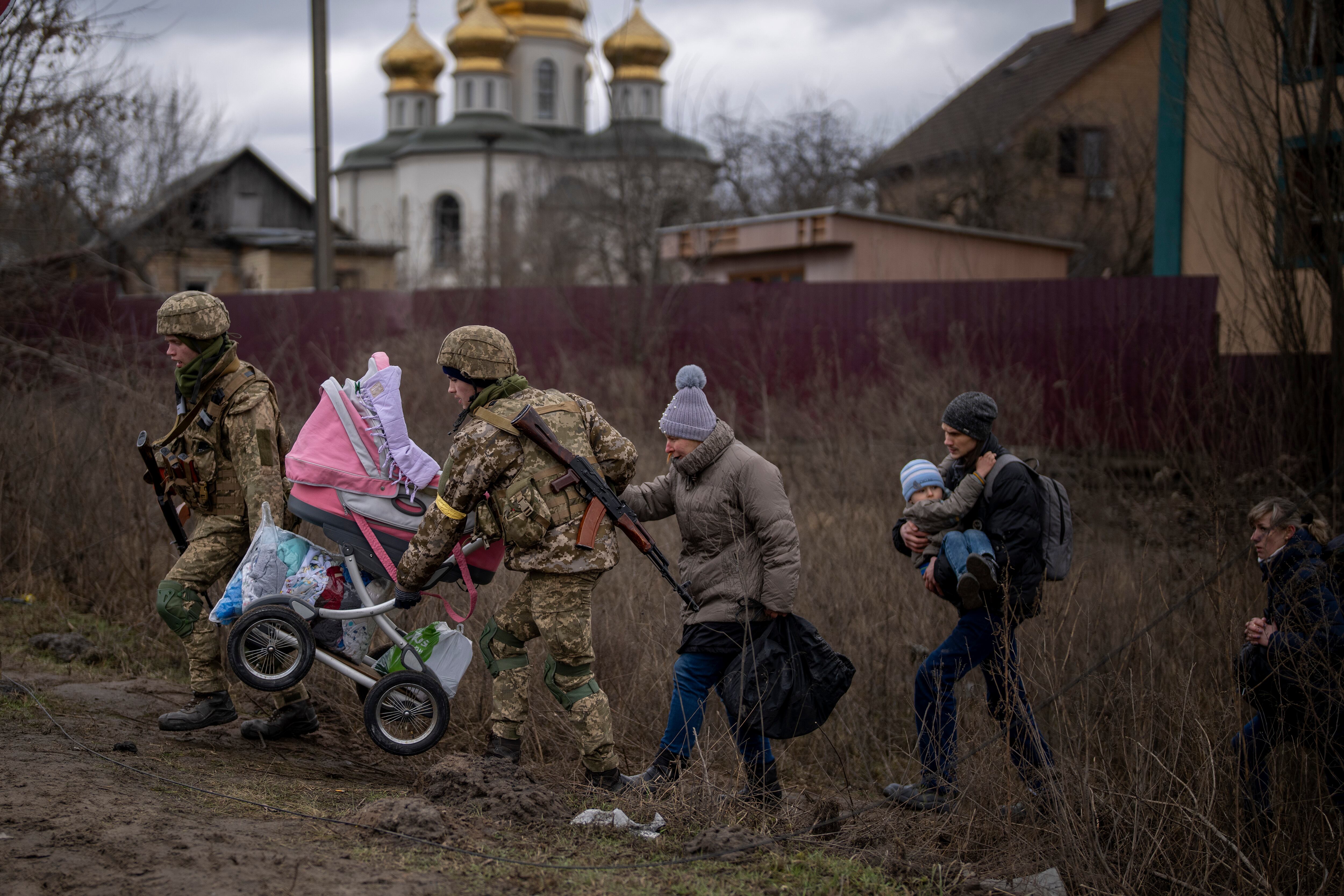The latest details about Russia’s attack on Ukraine:
Desperate plea
12:23 p.m. EST March 5
Ukrainian President Volodymyr Zelenskyy made a “desperate plea” to U.S. senators on Saturday to send more planes to help the country fight the Russian invasion.
Zelenskyy made the request on a call joined by more than 300 people, including senators, some House lawmakers and aides.
Senate Majority Leader Chuck Schumer, a Democrat from New York, said in a statement that Zelenskyy made a “desperate plea for Eastern European countries to provide Russian-made planes to Ukraine.”
“I will do all I can to help the administration to facilitate their transfer,” Schumer said.
RELATED

Schumer told Zelenskyy the U.S. lawmakers are inspired by him and by the strength and courage of the Ukrainian people, according to another person on the call who was granted anonymity to discuss it.
Zelenskyy’s focus “was on control of Ukrainian airspace, asking either for a [no-fly zone] or sending Ukraine Russian-made airframes and drones so that they can protect themselves,” Rep. Elissa Slotkin, a Michigan Democrat and former acting assistant Defense Secretary and CIA analyst, said in a Tweet Saturday morning,
The U.S. Congress also is working on a $10 billion package of military and humanitarian aide, and Schumer told Zelenskyy that lawmakers hope to send it quickly to Ukraine, the person said.
Zelenskyy told senators he needs planes and drones more than other security tools, according to a senior Senate aide granted anonymity to discuss the private meeting.
-Associated Press reporter Lisa Mascaro in Washington contributed to this report.
Americans should leave Russia now
12:15 p.m. EST March 5
The U.S. State Department has updated an earlier travel advisory and is now recommending that U.S. citizens leave Russia immediately.
The notice offers this guidance: “If you wish to depart Russia, you should make arrangements on your own as soon as possible. If you plan to stay in Russia, understand the U.S. Embassy has severe limitations on its ability to assist U.S. citizens, and conditions, including transportation options, may change suddenly.”

The department already has advised Americans not to travel to Russia. That warning cites “the unprovoked and unjustified attack by Russian military forces in Ukraine” and “the potential for harassment against U.S. citizens by Russian government security officials,” among other things.
The American ambassador in Moscow, John Sullivan, has scheduled a virtual town hall on Wednesday for U.S. citizens in Russia “in light of the rapidly developing situation” from the Russian invasion.
Putin warns 3rd parties against creating Ukraine no-fly zone
9:45 a.m. EST March 5
Russian President Vladimir Putin said Saturday that Moscow would consider any third-party declaration of a no-fly zone over Ukraine as “participation in the armed conflict.”
Speaking at a meeting with female pilots on Saturday, Putin said Russia would view “any move in this direction” as an intervention that “will pose a threat to our service members.”
“That very second, we will view them as participants of the military conflict, and it would not matter what members they are,” the Russian president said.
Ukrainian President Volodymyr Zelenskyy has pushed NATO to impose a no-fly zone over his country, warning that “all the people who die from this day forward will also die because of you” as Russian forces were battering strategic locations in Ukraine.

NATO countries refused on Friday to police a no-fly zone over Ukraine, warning that such a move could provoke widespread war in Europe with nuclear power Russia, the organization’s top civilian official said.
Speaking after chairing a meeting with U.S. Secretary of State Antony Blinken and his counterparts, NATO Secretary-General Jens Stoltenberg acknowledged the suffering of the Ukrainian people, as Russia ramps up its use of heavy firepower, shelling cities and other sites, forcing more than a million people out of the country.
“What is taking place now in Ukraine is horrific. It’s painful and we see human suffering, we see destruction at a scale we haven’t seen in Europe since the Second World War,” he said. But, he added: “We are not going to move into Ukraine, neither on the ground, nor in the Ukrainian airspace.”
Under a collective security guarantee binding NATO’s 30 member countries — Article 5 of its founding treaty — all allies must come to the defense of an ally if it finds itself under attack. Any shooting down of a NATO warplane by Russia could trigger that clause.
“The only way to implement a no-fly zone is to send NATO fighter planes into Ukrainian airspace, and then impose that no-fly zone by shooting down Russian planes,” Stoltenberg said. He said allies believe that “if we did that, we would end up with something that could end in a full-fledged war in Europe.”
-Yuras Karmanau, The Associated Press
Limited cease fire falls apart
9 a.m. EST March 5
A limited cease-fire that Russia declared to allow civilians to evacuate two cities in Ukraine quickly fell apart Saturday, and Ukrainian officials blamed Russian shelling for blocking the promised safe passage as Moscow tightened its grip on the southern coast and residents raced to escape areas not under siege.
The Russian defense ministry said it had agreed on evacuation routes with Ukrainian forces for Mariupol, a strategic port in the southeast, and the eastern city of Volnovakha. The two cities have been under attack for days, producing scenes of desperation, destruction and death that mirrored those elsewhere from the war in Ukraine.
The struggle to enforce the cease-fire showed the fragility of efforts to stop fighting across Ukraine as the number of people fleeing the country reached 1.4 million on the 10th day after Russian forces invaded its neigbor.
“We are doing everything on our part to make the agreement work,” President Volodymyr Zelenskyy’s said. “This is one of the main tasks for today. Let’s see if we can go further in the negotiation process.”
“The Russian side is not holding to the cease-fire and has continued firing on Mariupol itself and on its surrounding area,” said Kyrylo Tymoshenko, the deputy head of President Volodymyr Zelenskyy’s office. “Talks with the Russian Federation are ongoing regarding setting up a cease-fire and ensuring a safe humanitarian corridor.”
Russian armed forces “continue to launch missile and bomb strikes on Mariupol, Volnovakha and other Ukrainian cities,” Ukraine’s Ministry of Foreign Affairs said in a statement provided to Military Times Saturday morning.
“The ongoing shelling makes it impossible to open humanitarian corridors for the safe evacuation of civilians and the delivery of medicines and food,” said the statement. “The allegations of the Ministry of Defense of the Russian Federation that it is the Ukrainian authorities who are ehindering the departure of residents of the cities under siege are not true and constitute disinformation to justify the criminal actions of the Russian armed forces.
“The Russian side ignores the appeals of international humanitarian organizations, in particular the International Committee of the Red Cross, to cease fire in order to create safe conditions for the departure of civilians and wounded.”

Russia breached the deal in Volnovakha as well, Deputy Prime Minister Iryna Vereshchuk told reporters. “We appeal to the Russian side to stop firing,” she said. Meanwhile, Moscow outlet RIA Novosti carried a Russian defense ministry claim that the firing came from inside both cities against Russian positions.
Mariupol had been the scene of growing misery in recent days amid an assault that knocked out power and most phone service and raised the prospect of food and water shortages for hundreds of thousands of people in freezing weather. Pharmacies are out of medicine, Doctors Without Borders said.
A top official in Mariupol, Pavlo Kirilenko, the head of the Donetsk military-civil administration that includes the city, had said the humanitarian corridor would extend to Zaporizhzhia, 226 kilometers (140 miles) away.
In comments carried on Ukrainian television, Mariupol Mayor Vadym Boychenko said thousands of people had gathered for safe passage out of the city and buses were departing when shelling began.
“We value the life of every inhabitant of Mariupol and we cannot risk it, so we stopped the evacuation,” he said.
Before Russia announced the limited cease-fire, Ukraine had urged Moscow to create humanitarian corridors to allow children, women and the older adults to flee the fighting, calling them “question No. 1.”
But Russian Foreign Minister Sergey Lavrov on Saturday asserted that “the Ukrainian side, the most interested side here, it would seem, is constantly making up various pretexts to delay the beginning of another meeting.” He said Russia was ready for a third round of talks.
Diplomatic efforts continued as U.S. Secretary of State Antony Blinken arrived in Poland to meet with the prime minister and foreign minister, a day after attending a NATO meeting in Brussels in which the alliance pledged to step up support for eastern flank members.
Aeroflot, Russia’s flagship state-owned airline, announced that it plans to halt all international flights. except to Belarus, starting Tuesday in the wake of Western sanctions imposed on Russia.
While a vast Russian armored column threatening Ukraine’s capital remained stalled outside Kyiv, the new shelling in Mariupol showed Russia’s determination to cut Ukraine off from access to the Black Sea and the Sea of Azov, further damaging the country’s economy.
Despite the shelling, presidential adviser Oleksiy Arestovich said the situation was generally quiet Saturday and Russian forces “have not taken active actions since the morning.”
Ukraine’s president has lashed out at NATO for refusing to impose a no-fly zone over his country, warning that “all the people who die from this day forward will also die because of you.”
NATO has said a no-fly zone, which would bar all unauthorized aircraft from flying over Ukraine, could provoke widespread war in Europe with nuclear-armed Russia. But as the United States and other NATO members send weapons for Kyiv and more than 1 million refugees spill through the continent, the conflict is already drawing in countries far beyond Ukraine’s borders.
Russia continues to crack down on independent media reporting on the war, also blocking Facebook and Twitter, and more outlets say they are pausing their work inside the country.
And in a warning of a hunger crisis yet to come, the U.N. World Food Program has said millions of people inside Ukraine, a major global wheat supplier, will need food aid “immediately.”
Ukraine’s president was set to brief U.S. senators Saturday by video conference as Congress considers a request for $10 billion in emergency funding for humanitarian aid and security needs.
In a video message to antiwar protesters in several European cities, Zelenskyy appealed for help. “If we fall, you will fall,” he said.
The U.N. Security Council scheduled an open meeting for Monday on the worsening humanitarian situation. The United Nations estimates that 12 million people in Ukraine and 4 million fleeing to neighboring countries in the coming months will need humanitarian aid.
At least 351 civilians have been confirmed killed since Russia’s invasion on Feb. 24, but the true number is probably much higher, the U.N. human rights office has said. Russia said Wednesday 498 of its troops had been killed and has not updated since.
As homes in the northern city of Chernihiv burned from what locals blamed on the Russian shelling that’s targeted Ukraine’s urban areas from the start, one resident accused Europe of merely looking on. “We wanted to join NATO and the EU and this is the price we are paying, and NATO cannot protect us,” she said.
Kyiv’s central train station remained crowded with people desperate to flee. “People just want to live,” one woman, Ksenia, said.
Elsewhere in the capital, in a sign of nerves near breaking point, two people on a sidewalk froze in their tracks at the sound of a sharp bang. It was a garbage truck upending a bin.
-Yuras Karmanau, The Associated Press, Howard Altman, Military Times




